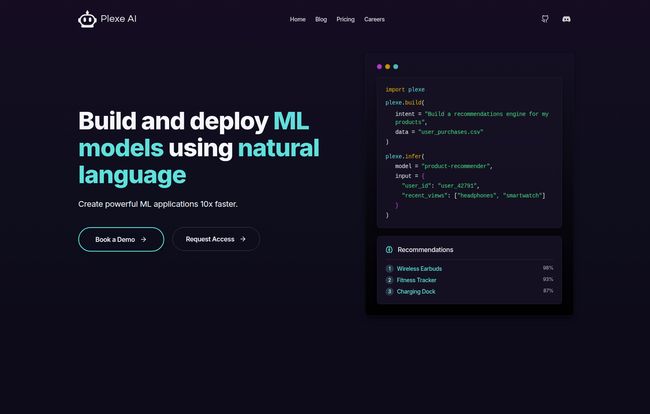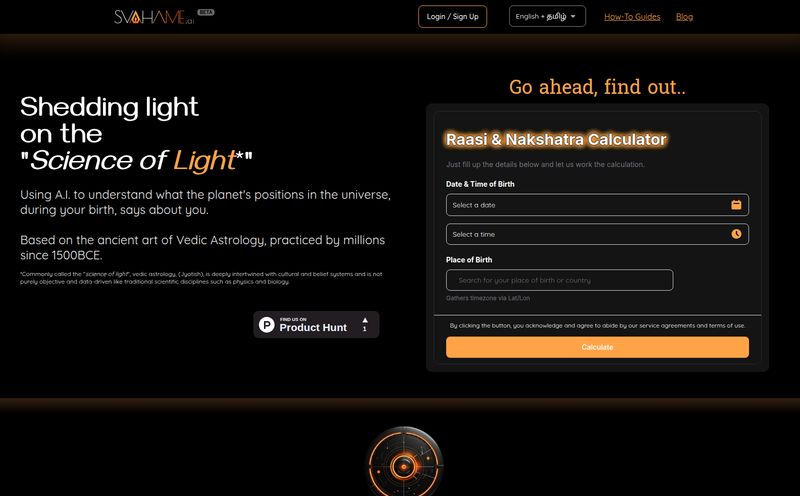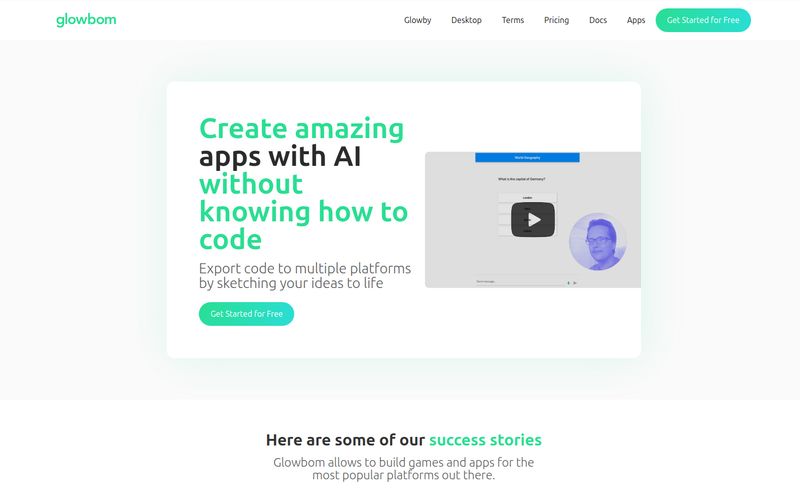I’ve been in the SEO and digital marketing game for a long time. Long enough to remember when 'big data' was just a buzzword and AI was something you only saw in movies. Now, it's everywhere. We're all told we need to be using machine learning for better recommendations, churn prediction, lead scoring… you name it. The problem? Most of us aren't data scientists. I can whip up a killer content strategy, but ask me to spin up a TensorFlow instance and my eyes glaze over. It's like being told you need to build a skyscraper when all you have is a hammer and a vague sense of dread.
So when I stumbled upon PlexeAI, the homepage hit me with a pretty bold claim: “Build and deploy ML models using natural language.”
No coding. Just… English? My inner skeptic, who’s been burned by over-hyped MarTech tools before, immediately raised an eyebrow. But the part of me that’s spent weeks trying to decipher Python libraries for a simple project was intrigued. Could this actually be the bridge over the technical chasm that so many businesses fall into? I had to find out.
So, What is PlexeAI, Really?
Let's cut through the marketing jargon. At its heart, PlexeAI is a platform designed to let you create, train, and launch machine learning models without writing a single line of code. Instead of wrestling with Python or R, you describe what you want in plain English. Think of it like having a genius data scientist on your team who you can just talk to. You say, “Hey, I want to build a recommendation engine for my e-commerce store based on user purchase history,” and it just… gets to work. At least, that's the promise.
Their site claims it can help you create powerful ML applications 10x faster. A bold claim, but if you factor in the time it takes for a non-technical person to even start learning the basics of ML development, it might not be that far off.

Visit PlexeAI
How This Magic Trick Supposedly Works
The whole process seems deceptively simple, broken down into three steps on their website. It’s a workflow that, frankly, makes sense. No unnecessary complexity, just a straight line from data to deployment.
Step 1: Connect Your Data
First things first, you can't build a model without data. PlexeAI lets you connect to your existing data sources. But here’s the part that made me nod in appreciation: it says it handles the preprocessing automatically. Anyone who's ever touched a raw dataset knows that 80% of the work is just cleaning and formatting the data. It's a soul-crushing, thankless task. If PlexeAI can genuinely automate this, it’s already saving users from a world of hurt.
Step 2: Describe Your Model
This is the main event. This is the part that feels like science fiction. You tell the platform what you want to build using plain text. The example on their site is literally:
intent = "build a recommendations engine for my blog"
That's it. It’s not just a no-code interface; it’s a language interface. You're not dragging and dropping blocks; you're having a conversation. This is a fundamentally different approach than anything I've seen in the no-code space, which usually relies on visual builders. Its a powerful concept.
Step 3: Integrate In Your App
And finally, the finish line. Once your model is built, PlexeAI offers one-click deployment. It spits out an API that your developers (or you, if you’re using other no-code tools like Bubble or Zapier) can easily plug into your application. This step is critical. A brilliant model that just sits on a server is useless. Getting it into the hands of users is what matters, and making that easy is a huge win.
Who is This For? And Who Should Probably Pass?
After digging in, I have a pretty clear picture of who would get massive value from PlexeAI.
It seems perfect for product managers, marketers, and startup founders. People who understand the business problem they want to solve with AI but don't have the technical chops or the budget to hire a full-time ML engineering team. Want to test a hypothesis about user behavior? Build a simple churn predictor? Create a 'related products' feature for your Shopify store? This seems tailor-made for that. It's for the doers, the experimenters, the ones who want to move fast.
Now, who should maybe look elsewhere? If you're a seasoned data scientist working on highly specialized, complex neural networks for, say, medical imaging analysis, this probably isn't for you. The reliance on natural language might abstract away too much of the fine-grained control you need. Sometimes you need to get your hands dirty with the algorithms themselves, and PlexeAI is designed to keep you from ever having to do that.
Let's Talk Money: The PlexeAI Price Tag
Okay, let's address the elephant in the room: the price. This isn't a $20-a-month hobbyist tool. PlexeAI is positioned as a serious B2B solution, and the pricing reflects that. You can't just sign up with a credit card either; you have to book a demo or request access, which suggests they're targeting qualified teams.
Here’s a breakdown of their public-facing plans:
| Plan | Price per Month | Best For | Key Features |
|---|---|---|---|
| Starter | $1,000 | Startups & Small Teams | 5 Model GBs, 1M prediction requests, Email Support |
| Growth | $3,000 | Growing Teams | 20 Model GBs, 4M requests, 10 concurrent models, Slack support |
| Business | $6,000 | Advanced Businesses | 30 Model GBs, 10M requests, 20 concurrent models, Custom integrations |
| Enterprise | Custom | Large Organizations | Custom everything, private deployments, dedicated support |
When you see '$1,000' for a starter plan, it's easy to get sticker shock. But let's put it in perspective. What's the fully-loaded cost of one machine learning engineer? Well over $100k a year in most markets. If PlexeAI lets a product manager do the work of a dedicated engineer for a fraction of the cost, that $12,000 annual price tag starts to look a lot more reasonable. It's a value proposition based on cost-avoidance and speed.
My Honest Take: The Good and The Not-So-Good
No tool is perfect. After my analysis, here's where I think PlexeAI shines and where it might stumble.
The Good Stuff
The speed and accessibility are undeniable. The idea of going from a raw dataset to a live API in minutes, not months, is genuinely transformative for businesses that have been locked out of the AI arms race. It truly democratizes the ability to try things. This isn't just a tool; it's an innovation engine. The automated data cleanup and one-click deployment are also massive, unsexy features that solve real-world bottlenecks.
The Reality Check
Okay, let's be real. The pricing, while justifiable in a corporate context, puts it out of reach for solo founders or bootstrappers just tinkering with an idea. Also, I have to wonder about the edge cases for the natural language processing. What happens when a request is ambiguous? How does it handle complex, multi-step logic? There's a black box element that might frustrate some users. And personally, the whole “book a demo” thing is a bit of a pet peeve of mine. I wish there was a sandboxed free trial to let people experience the magic for themselves before committing to a sales call.
Conclusion: Is This the Future of Applied AI?
So, is PlexeAI the answer to all our prayers? Maybe not for everyone, but for a huge, underserved segment of the business world, it just might be. It represents a shift from how you build AI to what you build with it. It abstracts away the complex mechanics and lets people focus on the business problem.
I came in skeptical, but I'm leaving impressed. PlexeAI isn't just another no-code tool; it's a 'no-barrier' tool. It’s a bet that the next big breakthroughs in applied AI won't come from data scientists in a lab, but from marketers, product managers, and founders who can now finally bring their ideas to life. And that’s a future I'm genuinely excited to see.
Frequently Asked Questions
- Do I need to know how to code to use PlexeAI?
- Absolutely not. That's the entire point. The platform is designed to be used by describing what you want in simple, plain English.
- What kinds of machine learning models can I build?
- Based on their examples and the common use cases for this type of platform, you can likely build things like recommendation engines, classification models (e.g., sentiment analysis, spam detection), and prediction models (e.g., customer churn, sales forecasting).
- Is PlexeAI expensive?
- It depends on your perspective. For a solo person or a small project, yes, the entry point of $1,000/month is significant. For a business comparing it to the cost of hiring a dedicated ML engineer (which can easily be $150,000+ per year), it can be seen as a very cost-effective alternative.
- How does PlexeAI handle my data's security and privacy?
- While not explicitly detailed on the main page, any reputable B2B platform in this space would adhere to strict data privacy protocols. They likely use secure, encrypted connections and have policies in place to ensure your proprietary data remains yours. This would be a key question to ask during a demo.
- Can I integrate PlexeAI with my existing software?
- Yes. Once a model is deployed, the platform provides an API. This is a standard way for different software applications to talk to each other, so your development team can easily integrate the model's predictions into your website, CRM, or internal tools.
- Why do I have to book a demo to get access?
- Many high-end B2B SaaS companies use this model to qualify leads and ensure their platform is a good fit for the customer's needs. It prevents them from being inundated with support requests from non-ideal customers and allows for a more personalized onboarding experience.
Reference and Sources
- PlexeAI Official Website
- PlexeAI Pricing Page
- Forbes - The Rise Of No-Code AI (illustrative example)



